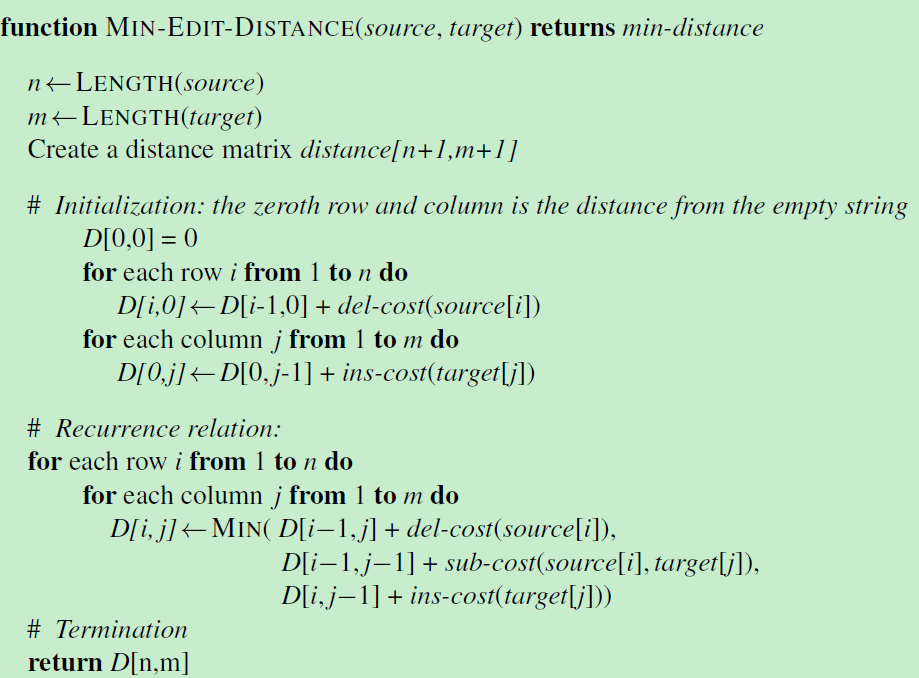最短編輯距離算法實現
一,算法介紹
在CS124課程的第一周提到 求解兩個字符串相似度的算法---Minimum Edit Distance(最短編輯距離)算法。該算法在NLP(自然語言處理)中也會用到。
如何定義相似度呢?任給兩個字符串X 和Y,使用以下三種操作將 字符串X 變到 字符串Y :①插入(Insert)操作;②刪除操作(delete);③替換操作(substitute)
比如 字符串X="intention" , 字符串Y="execution"。從字符串X 轉換成 字符串Y 如下圖所示:

定義:插入操作的代價為1,刪除操作的代價為1,替換操作的代價為2(稱為: Levenshtein distance)。那麽,"intention" 變成 "execution" 執行了三次替換,一次刪除,一次插入。因此,總代價為8
而這個代價又稱為編輯距離, 用之來 衡量 兩個字符串的相似程度。顯然,若兩個字符串越相似,則從一個字符串變到另一個字符串所需要的 “操作” 步驟 就越少。
二,動態規則求解最短編輯距離
為什麽能用動態規劃來求解呢??該問題可以分解成若幹個子問題;?子問題之間具有重疊性(可“查表”),具體可參考一些動態規劃的示例1,示例2.
假設字符串X的長度為n,字符串Y的長度為m,用d[n][m] 表示 字符串X 轉換成 字符串Y 的最短編輯距離
定義 d[i][j] 表示 字符串X的子串X[1...i] 轉換成 字符串Y 的子串 Y[1...j] 的最短編輯距離(這裏的 下標從1開始,不從0開始),有如下動態規劃公式:

要想從 長度為 i 的源字符串X 轉換成 長度為 j 的目標字符串Y,有三種方式:
①先將 源字符串X 的前 i-1 個字符 X[1...i-1] 轉換成 目標字符串Y[1...j], 然後再 刪除字符串X 的第 i 個字符source[i]
②先將 源字符串X[1...j] 轉換成 目標字符串Y[1...j-1] ,然後再 插入字符串Y的第 j 個字符 target[j]
③先將 源字符串X[1...i-1] 轉換成 目標字符串Y[1...j-1],然後 源字符串中的 第 i 個字符X[i] 替換為 目標字符串的第 j 個字符 Y[j]
為什麽 只有上述三種方式呢?
因為我們是將 源問題 的求解,分解成若幹個子問題的求解,子問題的規模比原問題要小1。源問題 X[1...i] 轉換成 Y[1...j] 。比如,子問題是:先將X[1...i-1] 轉換成 Y[1...j] ,...
結合前面定義的 操作代價(刪除和插入操作代價為1,替換操作為2),就是下面這個公式:

解釋一下為什麽 if source[i]=target[j]時,替換的 代價為0呢?if source[i]=target[j] 表明 字符串X 的第 i 個字符串 和 字符串Y的第 j 個字符是相同的
要想將 X[1...i] 轉換成 Y[1...j] ,對於第三種轉換方式:先將 源字符串X[1...i-1] 轉換成 目標字符串Y[1...j-1] ,既然:字符串X 的第 i 個字符串 和 字符串Y的第 j 個字符是相同的,那就相當於“自己替換自己”,或者說是 不需要替換操作了嘛。這也是下面代碼實現邏輯:
if (source.charAt(i-1) == target.charAt(j-1)) { dp[i][j] = dp[i - 1][j - 1];
三,代碼實現
偽代碼描述如下:

JAVA實現:
1 public class MinimumEditDistance { 2 3 public static void main(String[] args) { 4 MinimumEditDistance med = new MinimumEditDistance(); 5 String source = "execution"; 6 String target = "intention"; 7 int result = med.similarDegree(source, target); 8 System.out.println(result); 9 } 10 11 public int similarDegree(String source, String target) { 12 if(source == null || target == null) 13 throw new IllegalArgumentException("illegal input String"); 14 15 int sourceLen = source.length(); 16 int targetLen = target.length(); 17 18 int[][] dp = new int[sourceLen + 1][targetLen +1]; 19 //init 20 dp[0][0] = 0; 21 for(int i = 1; i <= sourceLen; i++) 22 dp[i][0] = i; 23 for(int i = 1; i <= targetLen; i++) 24 dp[0][i] = i; 25 26 for(int i = 1; i <= sourceLen; i++) { 27 for(int j = 1; j <= targetLen; j++) { 28 if (source.charAt(i-1) == target.charAt(j-1)) { 29 dp[i][j] = dp[i - 1][j - 1]; 30 }else{ 31 int insert = dp[i][j - 1] + 1;//source[0,i] to target[0,j-1] then insert target[j] 32 int delete = dp[i - 1][j] + 1;//source[0,i-1] to target[0,j] then delete source[i] 33 int substitute = dp[i - 1][j - 1] + 2;//source[0,i-1] to target[0,j-1] then substitute(source[i] by target[j]) 34 35 int min = min(insert, delete, substitute); 36 dp[i][j] = min; 37 } 38 } 39 } 40 return dp[sourceLen][targetLen]; 41 } 42 43 private int min(int insert, int delete, int substitute) { 44 int tmp = insert < delete ? insert:delete; 45 int min = tmp < substitute ? tmp:substitute; 46 return min; 47 } 48 }
參考:Stanford CS124課程
原文:http://www.cnblogs.com/hapjin/p/7467035.html
最短編輯距離算法實現
